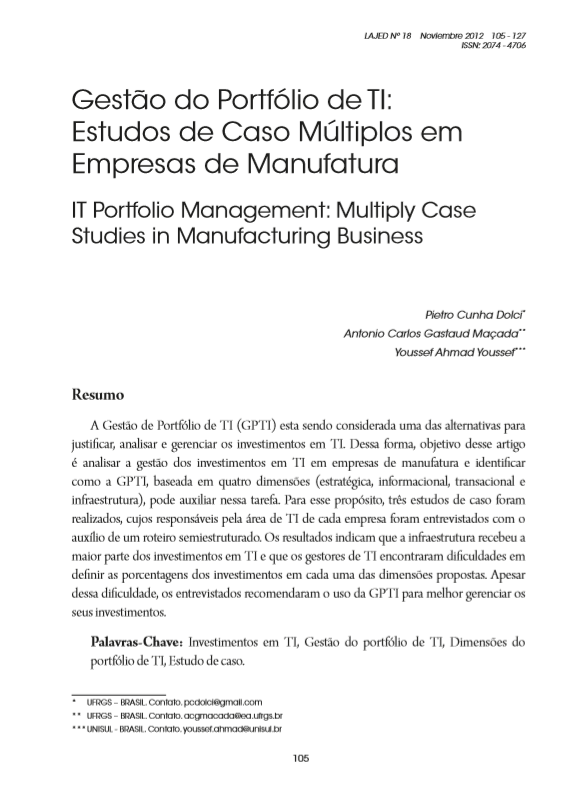Gestión de la cartera de TI: Estudios de caso múltiple en empresas de manufactura
DOI:
https://doi.org/10.35319/lajed.201218132Palabras clave:
Investimentos em TI, Gestão do Portfólio de TI, Dimensões do portfólio de TI, Estudo de casoResumen
A Gestão de Portfólio de TI (GPTI) esta sendo considerada uma das alternativas para justificar, analisar e gerenciar os investimentos em TI. Dessa forma, objetivo desse artigo é analisar a gestão dos investimentos em TI em empresas de manufatura e identificar como a GPTI, baseada em quatro dimensões (estratégica, informacional, transacional e infraestrutura), pode auxiliar nessa tarefa. Para esse propósito, três estudos de caso foram realizados, cujos responsáveis pela área de TI de cada empresa foram entrevistados com o auxílio de um roteiro semiestruturado. Os resultados indicam que a infraestrutura recebeu a maior parte dos investimentos em TI e que os gestores de TI encontraram dificuldades em definir as porcentagens dos investimentos em cada uma das dimensões propostas. Apesar dessa dificuldade, os entrevistados recomendaram o uso da GPTI para melhor gerenciar os seus investimentos.
Descargas
Citas
Aral, S. e Weill, P. (2007). IT Assets, Organizational Capabilities and Firm Performance: Do Resource Allocations and Organizational Differences Explain Performance Variation? Technical Research Report, Center for Information Systems Research, 1-27.
Bharadwaj, A. (2000). A Resource-Based Perspective on Information Technology Capability and Firm Performance: An Empirical Investigation. MIS Quarterly, 24 (1), 169-196.
Benbasat, I., I.; Goldstein, D. K. e Mead, M. (1987). The case research strategy in studies of information systems. MIS Quarterly, 11 (3), 369-386.
Byrd, T. A.; Lewis, B. R. e Bryan, R. W. (2006). The leveraging influence of strategic alignment on IT investment: An empirical examination. Information & Management, v. 43.
CIO. (2003). Diagrams to Help Build Your Portfolio Management Skills. Disponível em http://www.cio.com/article/31865/Diagrams_to_Help_Build_Your_Portfolio_Management_Skills. Acesso em 12 abr. 2007.
Churchill, G. A. Jr. (1999). Marketing Research–metodological foundations. Orlando: Dryden.
Datz, T. (2003). Portfólio Management Done Right. CIO, 16(14).
Davenport, T. H. (2002). Missão crítica: obtendo vantagem competitiva com os sistemas de gestão empresarial. Porto Alegre: Editora. Bookman.
Dehning, B.; Richardson, V. J. e Zmud, R. (2003). The Value Relevance of Announcements of Transformational Information Technology Investments. MIS Quarterly, 27(4), 637-656.
Dewan S., Shi, C. e Gurbaxani, V. (2003). Investigating the Risk-Return Relationship of Information Technology Investment: Firm-Level Empirical Analysis. Disponível em http://web.gsm.uci.edu/~sdewan/Home%20Page/MS-00524-2003.pdf. Acesso em: 13 ago. 2007.
Epstein, M. e Rejc, A. (2005). How to measure and improve the value of IT. Strategic Finance, 87 (4), 34-41.
Gil, A. (1999). Métodos e técnicas de pesquisa social. São Paulo: Atlas, 5º ed.
Gliedman, C.; Leaver, S. e Sedov, V. (2010). Visualizing the IT Portfolio with the Forrester Technology Investment Matrix. Forrester Research. May, pp. 1-10.
Hoppen, N. e Meirelles, F. S. (2005). Sistemas de informação: um panorama da pesquisa científica entre 1990 e 2003. Revista de Administração de Empresas, 45(1), 24-35, jan./mar.
Informationweek (2001). Payback Time: Making Sure ROI Measures Up. Disponível em http://www.informationweek.com/news/management/roi/showArticle.jhtml?articleID=6506422. Acesso em: 23 jun. 2007.
Informationweek (2008). As 100+ Inovadoras em TI. Disponível em http://www.informationweek.com.br/100mais/metodologia.asp. Acesso em 22 dez. 2008.
Jeffery, M. e Leliveld, I. (2004). Best Practices in IT Portfólio Management. MIT Sloan Management Review, 45(3), 41-49.
Kobelsky, K.; Hunter, S. e Richardson, V. J. (2008). Information technology, contextual factors and the volatility of firm performance. International Journal of Accounting Information Systems, v.9.
Lunardi, G.; Rios, L. R. e Maçada, A. C. G. (2005). Pesquisa em sistemas de informação: uma análise a partir dos artigos publicados no Enanpad e nas principais revistas nacionais em administração. In: Encontro da Associação Nacional de Pós-Graduação em Administração, 27., 2005, Brasília. Anais... Anpad: Rio de Janeiro.
Mahmood, M. A. e Mann, G. J. (1991). Measuring the impact of information technology on organizational strategic performance: a key ratios approach. IEEE.
Maizlish, B. e Handler, R. (2005). IT Portfólio Management Step-by-Step: Unlocking the Business Value of IT. New Jersey: John Wiley & Sons, Inc.
Mcfarlan, W. (1981). Portfolio approach to information systems. Harvard Business Review, Set/Out.
Pavani, L. (2006). Quem paga a conta da TI? Como tornar a gestão do orçamento eficaz. Info Corporate, ed. 37, Ed. Abril, Out., p.1-6.
Richardson, R. J.; Peres, J. A. S.; Wardeley, J. C.V.; Correia, L. M. e Peres, M. H. M. (1999). Pesquisa Social - Métodos e Técnicas. São Paulo: Atlas, 3º ed.
Rubinstein, M. (2002). Markowitz’s “Portfolio Selection”: A Fifty-Year Retrospective. The Journal of Finance. 57(2).
Schniederjans, M.J.; Hamaker, J.L. e Schniederjans, A.M. (2004). Information Technology Investment: Decision-Making Methodology. Singapure: World Scientific Publishing Co.
Symons, C.; Orlov, L. M.; Bright, S. e Brown, B. (2005). Optimizing the IT portfolio for maximum business value. Best Practices. Forrester Institute. September 30.
United States General Accounting Office. (2000). Information Technology Investment Management: a Framework for Assessing and Improving Process Maturity. Accounting and Information Management Division, May. Disponível em www.gao.gov/special.pubs/10_1_23.pdf . Acesso em: 11 ago. 2006.
Weill, P. e Aral, S. (2006). Generating Premium Returns on Your IT Investments. MIT Sloan Management Review, 47(2)39-48.
Weill, P. e Broadbent, M. (1998). Leveraging the New Infrastructure: How Market Leaders Capitalize on Information Technology. Boston: Harvard Business School Press.
Yin, R. K. (2005). Estudo de caso - planejamento e métodos. Porto Alegre: Bookman, 3. ed.





